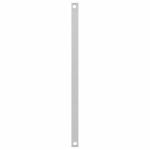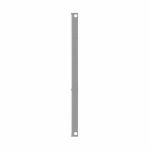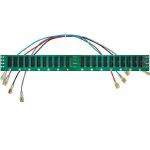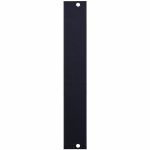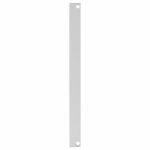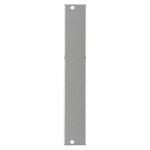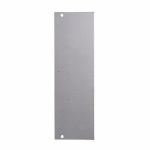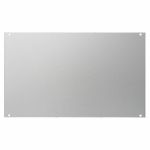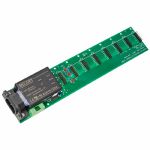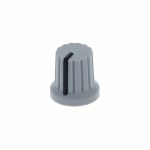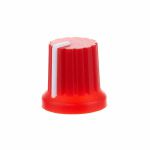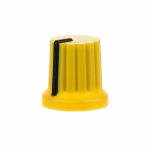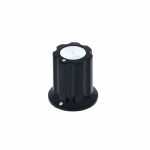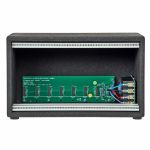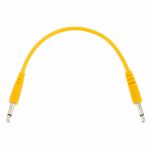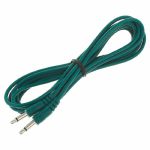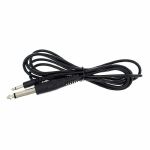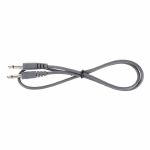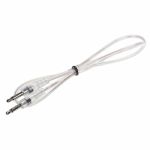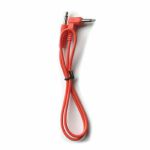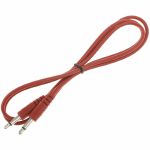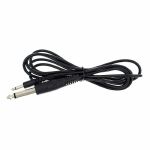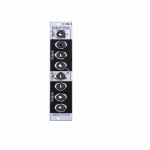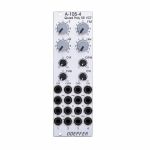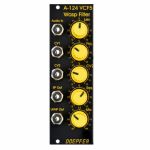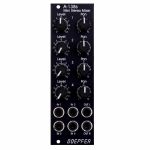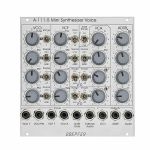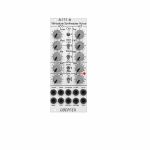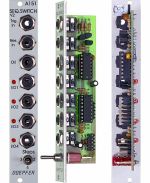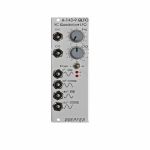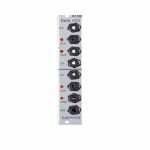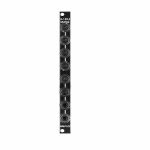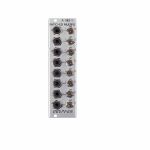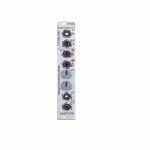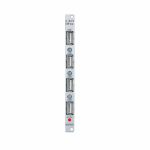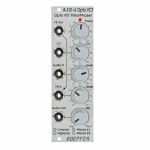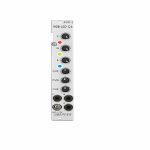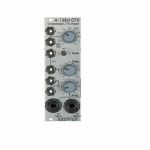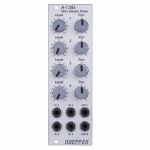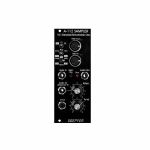安全なお買い物
Studio equipment
Our full range of studio equipment from all the leading equipment and software brands. Guaranteed fast delivery and low prices.
安全なお買い物
DJ equipment
Our full range of DJ equipment from all the leading equipment and software brands. Guaranteed fast delivery and low prices. Visit Juno DJ
Filter
Stock
Format
Brand
Featured
Price
Tags
Back catalogue: Studio Equipment
Juno's full catalogue of Studio EquipmentDoepfer A-100B1 Blank Panel 1TE (silver) (blank panel)
Cat: 755421 Rel: 14 Nov 19
Robust, blank front panel for use with modular racks & other applications - 1HP wide
Notes: Blank panel, 1HP, constructed from anodised aluminium, silver.
… Read more 8 in stock $3.35
Doepfer A-100B1.5 Blank Panel 1.5TE (silver) (blank panel)
Cat: 755422 Rel: 14 Nov 19
Robust, blank front panel for use with modular racks & other applications - 1.5 HP wide
Notes: Blank panel, 1.5 HP, constructed from anodised aluminium, silver.
… Read more 9 in stock $3.35
Cat: 763100 Rel: 31 Jan 20
Notes: Bus board to connect 14 modules
An assembled and tested bus board, 22 sockets, e.g. for customers who want to built their own case and need a bus board for A-100 modules, includes cables for connection to +/-12V power supply (4 wires with flat connectors on both ends, length about 30cm), but no mechanical parts (e.g. screws, spacers, nuts, washers).
In the new version of the A-100 bus board (labeled Version 6 / 2019) boxed pin headers are used which are equipped with a reverse protection (gap for the "nose" of the socket of the bus cable). When the bus cable coming from the module is connected to the boxed header in question the "nose" has to point to the right. The polarity of the cable is correct if the red wire of the bus cable then points to the bottom (to the continuous line labeled"RED WIRE" on the pc board). If this is not the case please do not connect the module to the bus board ! Otherwise both the module and the power supply (A-100PSU3) may be damaged ! In that case please contact the manufacturer of the module and ask for a suitable bus cable with the correct polarity of the connector.
The bus cables of original A-100 modules manufactured by Doepfer are equipped with suitable bus cables since 2012. Only for older A-100 modules manufactured before 2012 it may happen that the polarity of the 16 pin female connector of the bus cable is wrong (nose points to the left when red wire points to the bottom). This is because in the past unboxed pin headers were used and the position of the "nose" did not matter. In such a case please contact Doepfer or one of their dealers and order a suitable bus cable.
… Read moreAn assembled and tested bus board, 22 sockets, e.g. for customers who want to built their own case and need a bus board for A-100 modules, includes cables for connection to +/-12V power supply (4 wires with flat connectors on both ends, length about 30cm), but no mechanical parts (e.g. screws, spacers, nuts, washers).
In the new version of the A-100 bus board (labeled Version 6 / 2019) boxed pin headers are used which are equipped with a reverse protection (gap for the "nose" of the socket of the bus cable). When the bus cable coming from the module is connected to the boxed header in question the "nose" has to point to the right. The polarity of the cable is correct if the red wire of the bus cable then points to the bottom (to the continuous line labeled"RED WIRE" on the pc board). If this is not the case please do not connect the module to the bus board ! Otherwise both the module and the power supply (A-100PSU3) may be damaged ! In that case please contact the manufacturer of the module and ask for a suitable bus cable with the correct polarity of the connector.
The bus cables of original A-100 modules manufactured by Doepfer are equipped with suitable bus cables since 2012. Only for older A-100 modules manufactured before 2012 it may happen that the polarity of the 16 pin female connector of the bus cable is wrong (nose points to the left when red wire points to the bottom). This is because in the past unboxed pin headers were used and the position of the "nose" did not matter. In such a case please contact Doepfer or one of their dealers and order a suitable bus cable.
1 in stock $35.84
Doepfer A-100B4v Vintage Blank Panel 4TE (black) (blank panel)
Cat: 731210 Rel: 29 May 19
Robust, blank front panel for use with modular racks & other applications - 4HP wide
Notes: Blank panel, 4HP, constructed from anodised aluminium, black.
… Read more More than 10 in stock $6.97
Doepfer A-100B8v Vintage Blank Panel 8TE (black) (blank panel)
Cat: 731211 Rel: 29 May 19
Robust, blank front panel for use with modular racks & other applications - 8HP wide
Notes: Blank panel, 8HP, constructed from anodised aluminium, black.
… Read more 2 in stock $8.24
Doepfer A-100B2 Blank Panel 2TE (silver) (blank panel)
Cat: 755424 Rel: 14 Nov 19
Robust, blank front panel for use with modular racks & other applications - 2HP wide
Notes: Blank panel, 2HP, constructed from anodised aluminium, silver.
… Read more More than 10 in stock $3.35
Doepfer A-100B4 Blank Panel 4TE (silver) (blank panel)
Cat: 755425 Rel: 14 Nov 19
Robust, blank front panel for use with modular racks & other applications - 4HP wide
Notes: Blank panel, 4HP, constructed from anodised aluminium, silver.
… Read moreMore than 10 in stock $3.61
Doepfer A-100B8 Blank Panel 8TE (silver) (blank panel)
Cat: 755427 Rel: 14 Nov 19
Robust, blank front panel for use with modular racks & other applications - 8HP wide
Notes: Blank panel, 8HP, constructed from anodised aluminium, silver.
… Read more More than 10 in stock $4.12
Doepfer A-100B42 Blank Panel 42TE (silver) (blank panel)
Cat: 755428 Rel: 14 Nov 19
Robust, blank front panel for use with modular racks & other applications - 42HP wide
Notes: Blank panel, 42HP, constructed from anodised aluminium, silver.
… Read more 9 in stock $10.31
Doepfer A-100 SSB Small Supply Bus Board & Power Supply (power supply/bus board)
Cat: 755432 Rel: 13 Nov 19
Power supply & bus board with 8 connectors for modular synthesisers
Notes: A-100SSB is a combination of power supply and bus board with 8 connectors for A-100 modules, planned for applications with up to 8 modules and a max. current of 380 mA.
- Wide range mains voltage input 100-240V AC / 50-60 Hz
- IEC inlet on board for the connection of a suitable mains cable (a suitable mains cable has to be purchased by the customer locally, it's not included with the A-100SSB)
- Switching supply with +12V/380 mA and -12V/380mA for the operation of A-100 modules up to 380 mA total supply current
- Safety cover at the bottom side (covers all elements that lead mains voltage)
- On board fuse
- 8 bus connectors
- LED displays for +12V, -12V and +5V
- Dimensions: about 270 mm (length) x 55 mm (width) x 35 mm (height)
- Several 3mm holes for mounting the unit on a rear panel or bottom plate
… Read more- Wide range mains voltage input 100-240V AC / 50-60 Hz
- IEC inlet on board for the connection of a suitable mains cable (a suitable mains cable has to be purchased by the customer locally, it's not included with the A-100SSB)
- Switching supply with +12V/380 mA and -12V/380mA for the operation of A-100 modules up to 380 mA total supply current
- Safety cover at the bottom side (covers all elements that lead mains voltage)
- On board fuse
- 8 bus connectors
- LED displays for +12V, -12V and +5V
- Dimensions: about 270 mm (length) x 55 mm (width) x 35 mm (height)
- Several 3mm holes for mounting the unit on a rear panel or bottom plate
1 in stock $97.97
Click for better price!
or call +44 20 7424 1960
quote 755432
quote 755432
Cat: 757348 Rel: 28 Nov 19
Replacement knob for Doepfer modules - grey
Notes: High quality rotary knob, for use with Doepfer or a wide range of modules. Robust design with indented edges. Grey finish.
… Read more6 in stock $1.65
Cat: 757353 Rel: 28 Nov 19
Replacement knob for Doepfer modules - red
Notes: High quality rotary knob, for use with Doepfer or a wide range of modules. Robust design with indented edges. Red finish.
… Read more 3 in stock $2.05
Cat: 757356 Rel: 28 Nov 19
Replacement knob for Doepfer modules - green
Notes: High quality rotary knob, for use with Doepfer or a wide range of modules. Robust design with indented edges. Green finish.
… Read more4 in stock $2.57
Cat: 757359 Rel: 28 Nov 19
Replacement knob for Doepfer modules - yellow
Notes: High quality rotary knob, for use with Doepfer or a wide range of modules. Robust design with indented edges. Yellow finish.
… Read more7 in stock $2.05
Cat: 757360 Rel: 28 Nov 19
Replacement knob for Doepfer modules - vintage design
Notes: High quality rotary knob, for use with Doepfer or a wide range of modules. Robust design with indented edges. Retro style finish.
… Read moreMore than 10 in stock $3.61
Doepfer A-100LC1Vv Low Cost Synth Module Case With Integrated Power Supply & Bus Board (black, 100-240V) (synth module case)
Cat: 743113 Rel: 20 Aug 19
Compact budget Eurorack case
Notes: The A-100LC1v is a smaller version of the A-100LC3 with 48 HP of space. It is made out of raw wood, a black coating gives the Eurorack frame a vintage look. The built-in power supply, type A-100SSB, delivers up to 380 mA at +12 V and -12 V as well as 100 mA at +5 V.
The A-100LC1v comes equipped with one 48 HP measuring row for 3U modules. Its power supply features eight connectors for oscillators, filters and so forth. The case is connected to the grid via an IEC power socket.
… Read moreThe A-100LC1v comes equipped with one 48 HP measuring row for 3U modules. Its power supply features eight connectors for oscillators, filters and so forth. The case is connected to the grid via an IEC power socket.
1 in stock $194.91
Cat: 757305 Rel: 28 Nov 19
High-quality patch cable designed for use with Eurorack modules
Notes: - High-grade patch cable designed for modular units
- 3.5mm mono jack plugs
- Length: 15cm
- Yellow finish
… Read more- 3.5mm mono jack plugs
- Length: 15cm
- Yellow finish
More than 10 in stock $1.55
Cat: 757310 Rel: 28 Nov 19
High-quality patch cable designed for use with Eurorack modules
Notes: - High-grade patch cable designed for modular units
- 3.5mm mono jack plugs
- Length: 30cm
- Black finish
… Read more- 3.5mm mono jack plugs
- Length: 30cm
- Black finish
More than 10 in stock $1.55
Cat: 757325 Rel: 04 Sep 21
High-quality patch cable designed for use with Eurorack modules
Notes: - High-grade patch cable designed for modular units
- 3.5mm mono jack plugs
- Length: 120cm
- Blue finish
… Read more- 3.5mm mono jack plugs
- Length: 120cm
- Blue finish
5 in stock $2.05
Cat: 757328 Rel: 02 Dec 19
High-quality patch cable designed for use with Eurorack modules
Notes: - High-grade patch cable designed for modular units
- 3.5mm mono jack plugs
- Length: 200cm
- Green finish
… Read more- 3.5mm mono jack plugs
- Length: 200cm
- Green finish
More than 10 in stock $2.57
Cat: 757329 Rel: 28 Nov 19
Adapter cable for modular systems
Notes: - 6.3 mm jack male mono to 3.5 mm jack male mono
- Length: 1.5 metres
… Read more- Length: 1.5 metres
More than 10 in stock $8.24
Cat: 769128 Rel: 17 Jul 20
Modular patch cable
Notes: Patch cable for modular synthesizer 80 cm, transparent, mono jack plug 3.5 mm at each end.
… Read moreMore than 10 in stock $2.57
Cat: 757313 Rel: 28 Nov 19
High-quality patch cable designed for use with Eurorack modules
Notes: - High-grade patch cable designed for modular units
- 3.5mm mono jack plugs
- Length: 50cm
- Grey finish
… Read more- 3.5mm mono jack plugs
- Length: 50cm
- Grey finish
More than 10 in stock $1.55
Cat: 757316 Rel: 28 Nov 19
High-quality patch cable designed for use with Eurorack modules
Notes: - High-grade patch cable designed for modular units
- 3.5mm mono jack plugs
- Length: 50cm
- Transparent cabling
… Read more- 3.5mm mono jack plugs
- Length: 50cm
- Transparent cabling
More than 10 in stock $2.05
Cat: 757319 Rel: 28 Nov 19
High-quality patch cable designed for use with Eurorack modules
Notes: - High-grade patch cable designed for modular units
- 3.5mm mono jack plugs
- Length: 50cm
- Angled connector on one end
- Orange finish
… Read more- 3.5mm mono jack plugs
- Length: 50cm
- Angled connector on one end
- Orange finish
More than 10 in stock $1.81
Cat: 757323 Rel: 28 Nov 19
High-quality patch cable designed for use with Eurorack modules
Notes: - High-grade patch cable designed for modular units
- 3.5mm mono jack plugs
- Length: 80cm
- Red finish
… Read more- 3.5mm mono jack plugs
- Length: 80cm
- Red finish
More than 10 in stock $1.81
Cat: 757331 Rel: 28 Nov 19
Adapter cable for modular systems
Notes: - 6.3 mm jack male mono to 3.5 mm jack male mono
- Length: 3 metres
… Read more- Length: 3 metres
7 in stock $10.06
Doepfer A-119 External Input Envelope Follower Module (silver) (external/envelope follower/preamp/controller/comparator synth module)
Cat: 577771 Rel: 29 Nov 17
Envelope follower & pre-amplifier for microphone/line-signals - 8HP
Notes: Module A-119 (External Input / Envelope Follower) is designed to allow external audio signals to be integrated into the System A-100. It comprises a pre-amp, envelope follower, and comparator.
The pre-amp has two inputs: an unbalanced input for line level signals, with a gain factor of from 0 to 20, and a balanced input with a gain factor of from 0 to 500, for insertion of low level signals, for instance from a microphone or electric guitar.
The Envelope Follower reads the signal level of the input, and puts out a proportional voltage as an envelope at its own output.
The comparator generates a gate signal whenever the input goes above an adjustable trigger threshold.
Three LED's help you keep track of overload, the envelope, and the gate signal.
… Read moreThe pre-amp has two inputs: an unbalanced input for line level signals, with a gain factor of from 0 to 20, and a balanced input with a gain factor of from 0 to 500, for insertion of low level signals, for instance from a microphone or electric guitar.
The Envelope Follower reads the signal level of the input, and puts out a proportional voltage as an envelope at its own output.
The comparator generates a gate signal whenever the input goes above an adjustable trigger threshold.
Three LED's help you keep track of overload, the envelope, and the gate signal.
5 in stock $67.03
Click for better price!
or call +44 20 7424 1960
quote 577771
quote 577771
Doepfer A-180-3 Dual Buffered Multiple Module (silver) (dual/stereo/multiple synth module)
Cat: 751720 Rel: 23 Oct 19
Dual buffered 1-in-3 multiple module - 4HP
Notes: Module A-180-3 is a dual buffered 1-in-3 multiple. The signal applied to the input socket appears as a buffered signal at the three output sockets. Each output has its own buffer, i.e. the three output sockets are not simply connected to each other. The lower output of the upper unit is normalled in the factory to the input of the lower unit. That way the module works as a single 1-in-6 buffered multiple provided that no signal is applied to the input of the lower unit. But it's also possible to pick-up the bus CV and normalize the input socket of the lower unit to the bus CV.
Application: copying/buffering of CV, gate and audio signals.
… Read moreApplication: copying/buffering of CV, gate and audio signals.
1 in stock $51.56
Click for better price!
or call +44 20 7424 1960
quote 751720
quote 751720
Doepfer A-105-4 Quad Poly SSM VCF Polyphonic Filter Module (filter/quad synth module)
Cat: 676691 Rel: 21 Sep 18
Polyphonic filter with four identical 24dB Lowpass filters 8HP
Notes: A-105-4 is our first polyphonic filter and contains four
identical 24dB Lowpass filters (SSM2044 type). It has
available common manual controls and CV inputs with
attenuators for these parameters:
Frequency (F)
Frequency Modulation Intensity (FM)
Resonance (Q)
Audio Input Level (L)
Each filter has available a separate FM input as well as an Audio Input and Output. The FM input is typically connected to the output of the associated envelope generator (e.g. A-141-4).
The envelope amount for all four filters is controlled by the FM knob and the CVFM input by means of four built-in VCAs, which are controlled by the FM control and CVFM input. This allows also voltage control of the envelope amounts.
In addition common frequency modulation for all filters is possible (e.g. by an LFO). For this the CVF input with attenuator can be used. The range of the audio input level control (L) allows also clipping/distortion with typical A-100 audio levels
(e.g. from A-111-4) at the filter inputs. Even this parameter is voltage controllable as well as the resonance (Q).
Application: polyphonic patches (four VCFs with same parameters).
… Read moreidentical 24dB Lowpass filters (SSM2044 type). It has
available common manual controls and CV inputs with
attenuators for these parameters:
Frequency (F)
Frequency Modulation Intensity (FM)
Resonance (Q)
Audio Input Level (L)
Each filter has available a separate FM input as well as an Audio Input and Output. The FM input is typically connected to the output of the associated envelope generator (e.g. A-141-4).
The envelope amount for all four filters is controlled by the FM knob and the CVFM input by means of four built-in VCAs, which are controlled by the FM control and CVFM input. This allows also voltage control of the envelope amounts.
In addition common frequency modulation for all filters is possible (e.g. by an LFO). For this the CVF input with attenuator can be used. The range of the audio input level control (L) allows also clipping/distortion with typical A-100 audio levels
(e.g. from A-111-4) at the filter inputs. Even this parameter is voltage controllable as well as the resonance (Q).
Application: polyphonic patches (four VCFs with same parameters).
1 in stock $187.69
Doepfer A-124 VCF5 Wasp Filter 12dB Multimode Filter Module (special edition, black/yellow) (filter synth module)
Cat: 671564 Rel: 29 Nov 17
12dB multi-mode filter with unique classic circuitry, based on the filter from the 70s EDP Wasp synth
Notes: Module A-124 is a special 12dB multimode filter using the "strange" filter circuit of the "EDP Wasp" (an analog synthesizer with black/yellow case built end of the seventies, manufactured by the UK company "Electronic Dream Plant" with Chris Huggett und Adrian Wagner). This design "abuses" digital inverters as analog operational amplifiers leading to distortions and other "dirty" effects that generate the specific sound of this filter. The filter is equipped with a band pass output and a combined low/notch/high pass output. For this output a control knob defines the relation between low and high pass signal. If both signals appear at the same level (i.e. middle position of the Mix knob) one obtains a notch filter. Otherwise the low or high pass signal predominates. The module does not feature self-oscillation in contrast to most of the other filters of the A-100 system.
Inputs: Audio In, CV In (2x)
Outputs: Bandpass Out, Low/Highpass Mix-Out
Controls: Audio and CV attenuator, Frequency, Resonance, LP/HP Mix
The function and operation of this module is very similar to the module SEM VCF A-106-5. But the sound of both filters is very different! The only functional difference is the position of the sockets and controls, and the function of the controls CV2 (A-124: normal attenuator, A-106-5: polarizer).
- 3U Eurorack module, 8HP wide, 45mm deep
- Current draw 30mA
… Read moreInputs: Audio In, CV In (2x)
Outputs: Bandpass Out, Low/Highpass Mix-Out
Controls: Audio and CV attenuator, Frequency, Resonance, LP/HP Mix
The function and operation of this module is very similar to the module SEM VCF A-106-5. But the sound of both filters is very different! The only functional difference is the position of the sockets and controls, and the function of the controls CV2 (A-124: normal attenuator, A-106-5: polarizer).
- 3U Eurorack module, 8HP wide, 45mm deep
- Current draw 30mA
9 in stock $78.38
Click for better price!
or call +44 20 7424 1960
quote 671564
quote 671564
Doepfer A-138sv Mini Stereo Mixer Vintage Edition Module (black) (dual/stereo/mixer/panning/quad synth module)
Cat: 684443 Rel: 30 Apr 18
Four-channel stereo mixer - 8HP
Notes: A-138s is a simple but useful 4-in-2 mixing tool. It has four inputs available. Each input is equipped with an attenuator (Level) and a panning control that is used to distribute the signal to the left and right output. Beyond stereo mixing it is equally suited to create variable parallel routings. For example: Any of the four inputs may be routed in variable intensity to feed two filters.
You may regard the A-138s as a smaller version of the A-138m Matrix Mixer.
Inputs and outputs are DC coupled, i.e. the module can be used for the mixing of control signals too.
- 3U Eurorack module, 8 HP wide, 30 mm in depth
- Power consumption: 10 mA at +12 V and 10 mA at -12 V
… Read moreYou may regard the A-138s as a smaller version of the A-138m Matrix Mixer.
Inputs and outputs are DC coupled, i.e. the module can be used for the mixing of control signals too.
- 3U Eurorack module, 8 HP wide, 30 mm in depth
- Power consumption: 10 mA at +12 V and 10 mA at -12 V
4 in stock $84.57
Click for better price!
or call +44 20 7424 1960
quote 684443
quote 684443
Doepfer A-111-5 Mini Synthesiser Voice Module (silver) (envelope generator/filter/LFO/oscillator/VCA/synth voice synth module)
Cat: 785445 Rel: 10 Sep 20
A complete monophonic synthesiser module (modular version of Dark Energy).
Notes: A fully modular, Eurorack-format version of the excellent Dark Energy synth, the A-111-5 offers VCO, VCF, LFOs, VCA and envelope generator in a compact format. Brilliant value for a starter system.
Supplier's Notes:
Module A-111-5 is a complete monophonic synthesizer module that includes these components (modular version of Dark Energy):
VCO
Manual tune control (with an internal jumper the range can be set to ~ +/-1 half an octave or ~ +/-2.5 octaves)
Range switch -1 / 0 / +1 octave
Frequency range about 10Hz ... 12kHz - FM (frequency modulation) control with modulation source switch (LFO1 / off / ADSR)
Manual pulsewidth control for rectangle waveform
PWM control with modulation source switch (LFO2 / off / ADSR)
Waveform switch (sawtooth / off / triangle)
The sum of the waveform chosen by this switch and the rectangle is fed into the VCF (to turn the rectangle off the PW control has to be set fully CCW)
External CV input for VCO frequency (1V/octave)
External CV input for external PWM of the rectangle - internal CV input for frequency (1V/octave) connected to the A-100 bus via jumper, the jumper can be used to interrupt this internal connection if not wanted
VCF
24 dB low pass
~ 12 octaves frequency range
Manual frequency control
Tracking switch half - off - full (internally connected to the external frequency CV input of the VCO, i.e. the VCF tracks to the VCO if the switch is set to "half" or "full" position)
XM: exponential FM (frequency modulation) control with modulation source switch (LFO2 / off / ADSR)
LM: linear FM (frequency modulation) control to modulate the VCF by the triangle of the VCO in a linear (!) manner
Manual resonance control (up to self oscillation)
External audio input (this signal is added to the VCO signal)
External CV input for filter frequency - 1V/octave tracking for usage of the VCF as a sine wave oscillator (not as precise as the VCO but much better than most of the other filters)
VCA
Manual amplitude control
AM (amplitude modulation) control with modulation source switch (LFO1 / off / ADSR)
External CV input for VCA amplitude - special control scale: exponential scale in the range from about -20dB to -80/90dB, linear scale from about -20dB to 0dB (Remark: this special control scale results in a loudness behaviour that is a bit different from pure linear or exponential VCA)
LFO1 and LFO2
Manual frequency control
Waveform switch (triangle / off / rectangle)
Range switch (low, audio, medium) - LED display (dual green/red color for positive/negative share of the signal)
The inverted LFO1 signal is available as an additional socket (to use the LFO1 signal for external modules)
An internal jumper can be used to select between the LFO1 signal or the inverted LFO1 signal
ADSR
Manual controls for Attack, Decay, Sustain, Release
Range switch (long, short, medium) - blue LED display
ADSR signal is available as an additional socket (to use the ADSR signal for external modules)
Gate input connected to the A-100 bus via jumper, the jumper can be used to interrupt this internal connection if not wanted
Remarks:
As the LFO frequencies can go up to moderate audio range (~ 5kHz) even audio FM effects of VCO (pitch and pulsewidth), VCF and ADSR are possible.
If the VCO is turned off (waveform switch = center position, pulsewidth control = fully CCW) and the VCF resonance is set to maximum the module can be used as a sine oscillator. The sine can be modulated in a linear manner from the triangle wave of the VCO and by LFO2 in an exponential manner at the same time !
From the factory the socket labelled "LFO1" outputs the inverted LFO1 signal. But as the module has several internal pin headers available even another signal may appear at this socket by changing the internal module patch. These six pin headers are available: LFO1 output, LFO2 output, ADSR output, inverter input, inverter output, output socket. The internal default patch is LFO1 -> inverter input, inverter output -> output socket (i.e. socket = inverted LFO1). But even another signal can be patched to this socket (e.g. inverted ADSR, non-inverted LFO1, inverted or non-inverted LFO2). It is also possible to add a blind panel next to the A-111-5 with a couple of sockets that are connected to the corresponding pins of the A-111-5 pc board. The in- and outputs of the VCO, VCF and VCA are not available as pin headers because the VCO, VCF and VCA are internally connected in the circuit which is used in this module.
… Read moreSupplier's Notes:
Module A-111-5 is a complete monophonic synthesizer module that includes these components (modular version of Dark Energy):
VCO
Manual tune control (with an internal jumper the range can be set to ~ +/-1 half an octave or ~ +/-2.5 octaves)
Range switch -1 / 0 / +1 octave
Frequency range about 10Hz ... 12kHz - FM (frequency modulation) control with modulation source switch (LFO1 / off / ADSR)
Manual pulsewidth control for rectangle waveform
PWM control with modulation source switch (LFO2 / off / ADSR)
Waveform switch (sawtooth / off / triangle)
The sum of the waveform chosen by this switch and the rectangle is fed into the VCF (to turn the rectangle off the PW control has to be set fully CCW)
External CV input for VCO frequency (1V/octave)
External CV input for external PWM of the rectangle - internal CV input for frequency (1V/octave) connected to the A-100 bus via jumper, the jumper can be used to interrupt this internal connection if not wanted
VCF
24 dB low pass
~ 12 octaves frequency range
Manual frequency control
Tracking switch half - off - full (internally connected to the external frequency CV input of the VCO, i.e. the VCF tracks to the VCO if the switch is set to "half" or "full" position)
XM: exponential FM (frequency modulation) control with modulation source switch (LFO2 / off / ADSR)
LM: linear FM (frequency modulation) control to modulate the VCF by the triangle of the VCO in a linear (!) manner
Manual resonance control (up to self oscillation)
External audio input (this signal is added to the VCO signal)
External CV input for filter frequency - 1V/octave tracking for usage of the VCF as a sine wave oscillator (not as precise as the VCO but much better than most of the other filters)
VCA
Manual amplitude control
AM (amplitude modulation) control with modulation source switch (LFO1 / off / ADSR)
External CV input for VCA amplitude - special control scale: exponential scale in the range from about -20dB to -80/90dB, linear scale from about -20dB to 0dB (Remark: this special control scale results in a loudness behaviour that is a bit different from pure linear or exponential VCA)
LFO1 and LFO2
Manual frequency control
Waveform switch (triangle / off / rectangle)
Range switch (low, audio, medium) - LED display (dual green/red color for positive/negative share of the signal)
The inverted LFO1 signal is available as an additional socket (to use the LFO1 signal for external modules)
An internal jumper can be used to select between the LFO1 signal or the inverted LFO1 signal
ADSR
Manual controls for Attack, Decay, Sustain, Release
Range switch (long, short, medium) - blue LED display
ADSR signal is available as an additional socket (to use the ADSR signal for external modules)
Gate input connected to the A-100 bus via jumper, the jumper can be used to interrupt this internal connection if not wanted
Remarks:
As the LFO frequencies can go up to moderate audio range (~ 5kHz) even audio FM effects of VCO (pitch and pulsewidth), VCF and ADSR are possible.
If the VCO is turned off (waveform switch = center position, pulsewidth control = fully CCW) and the VCF resonance is set to maximum the module can be used as a sine oscillator. The sine can be modulated in a linear manner from the triangle wave of the VCO and by LFO2 in an exponential manner at the same time !
From the factory the socket labelled "LFO1" outputs the inverted LFO1 signal. But as the module has several internal pin headers available even another signal may appear at this socket by changing the internal module patch. These six pin headers are available: LFO1 output, LFO2 output, ADSR output, inverter input, inverter output, output socket. The internal default patch is LFO1 -> inverter input, inverter output -> output socket (i.e. socket = inverted LFO1). But even another signal can be patched to this socket (e.g. inverted ADSR, non-inverted LFO1, inverted or non-inverted LFO2). It is also possible to add a blind panel next to the A-111-5 with a couple of sockets that are connected to the corresponding pins of the A-111-5 pc board. The in- and outputs of the VCO, VCF and VCA are not available as pin headers because the VCO, VCF and VCA are internally connected in the circuit which is used in this module.
1 in stock $276.39
Doepfer A-111-6 Miniature Synthesiser Voice Slim Line Series Module (silver) (synth voice synth module)
Cat: 731937 Rel: 15 Nov 19
Complete miniature monophonic synthesiser module - 10HP
Notes: VCO:
- Tune: manual tune control (with an internal jumper the range can be set to ~ +/-1 half an octave or ~ +/-2.5 octaves)
- Oct: range switch -1 / 0 / +1 octave
- Mod: modulation depth (attenuator wired to the Mod. socket)
- Dest: switch that is used to address the modulation to frequency modulation (position FM) or pulsewidth modulation (positon PM), in centre positon no modulation
- PW: manual pulsewidth control for rectangle waveform, PW can be also modulated by the Mod. input as mentioned above
- Wave: waveform switch (sawtooth / off / triangle), the sum of the waveform chosen by this switch and the rectangle is fed into the VCF (to turn the rectangle off the PW control has to be set fully CCW or fully CW)
- 1V/Oct. (socket): external CV input for VCO frequency (1V/octave)
- Access to internal bus CV (via jumper, optional, please remove the bus jumper if this feature is not used to avoid unwanted frequency modulation as then the unused CV line of the bus works as a kind of antenna)
- Triangle core VCO, frequency range about 32Hz ... 8kHz
Balance unit:
- The balance unit is made of two VCAs which are controlled by the sum of manual Balance control and the balance CV input in the opposite direction.
- The audio input of VCA1 is hard-wired to the VCO output, audio input 2 is connected to the socket Ext.In.
- The output of the balance unit is used as audio input for the VCF
- Bal.: manual balance control, fully CCW the internal VCO is used, fully CW the external signal (Ext.In) is used, at centre position both signals have about the same level
- CV Bal.: CV input for balance (range about 0...+5V)
- Ext. In: external audio input for VCA2, about 5 Vpp level required for similar loudness as the internal VCO
- This socket is normalled to the internal VCO suboctave f/2 signal (rectangle with half the frequency), if no external signal is applied the suboctave signal is used as the second signal for the balance unit
VCF:
- 24 dB low pass
- Frq: manual frequency control
- FM1: frequency modulation depth (attenuator wired to the VCF FM1 socket, the socket is normalled to the internal Envelope signal and then FM1 controls the modulation depth of the internal envelope applied to the filter)
- FM2 (socket) : second CV input for VCF without attenuator (about 1V/octave), can be used e.g. for VCF tracking by connecting the same CV which is used also for the VCO frequency
- Res: manual resonance control (up to self oscillation)
- If the VCO is turned off (waveform switch = centre position, pulsewidth control = fully CCW or CW) and the VCF resonance is set to maximum the module can be used as a sine oscillator, the tracking at socket VCF FM2 is about 1V/octave (not as precise as the VCO but much better than most other filters)
- ~ 11 octaves frequency range (~ 10 Hz ... 20kHz)
VCA:
- Gain: manual amplitude control (initial gain), can be used to open the VCA without envelope signal
- VCA (switch): used to switch between gate and envelope as control signal for the VCA, in centre position the VCA is not controlled by envelope or gate
- Note: when gate is used the VCA is controlled directly by the gate signal (i.e. hard on/off), this may lead to clicking noise under certain conditions (especially with low VCO/VCF frequencies)
- Special control scale: exponential scale in the range from about -20dB to -80/90dB, linear scale from about -20dB to 0dB
- Remark: this special control scale results in a loudness behaviour that is a bit different from pure linear or exponential VCAs
- Out: audio output of the module (= VCA output)
Envelope:
- Gate (socket): Gate input (min. +5V), can be normalled to the bus gate signal by means of a jumper
- Att: manual control for Attack
- D/R: manual control for Decay/Release
- Env. (switch): used to switch between A/D, ADSR and A/R mode of the envelope generator, in centre position (ADSR) the sustain level is fixed to about 50%
- Envelope (socket): envelope output (about +10V)
- CVT (socket): CV input for time control, by means of two internal jumpers one can select which time parameters are controlled by the CVT input (e.g. A only or D/R only or A/D/R) and in which direction (i.e. if an increasing CVT shortens or stretches the time parameter in question)
- Envelope LED display
- Attack time range: ~ 1ms ... 5 sec (can be extended by using the CVT input)
- Decay/Release time range: ~ 1ms ... 15 sec (can be extended by using the CVT input)
… Read more- Tune: manual tune control (with an internal jumper the range can be set to ~ +/-1 half an octave or ~ +/-2.5 octaves)
- Oct: range switch -1 / 0 / +1 octave
- Mod: modulation depth (attenuator wired to the Mod. socket)
- Dest: switch that is used to address the modulation to frequency modulation (position FM) or pulsewidth modulation (positon PM), in centre positon no modulation
- PW: manual pulsewidth control for rectangle waveform, PW can be also modulated by the Mod. input as mentioned above
- Wave: waveform switch (sawtooth / off / triangle), the sum of the waveform chosen by this switch and the rectangle is fed into the VCF (to turn the rectangle off the PW control has to be set fully CCW or fully CW)
- 1V/Oct. (socket): external CV input for VCO frequency (1V/octave)
- Access to internal bus CV (via jumper, optional, please remove the bus jumper if this feature is not used to avoid unwanted frequency modulation as then the unused CV line of the bus works as a kind of antenna)
- Triangle core VCO, frequency range about 32Hz ... 8kHz
Balance unit:
- The balance unit is made of two VCAs which are controlled by the sum of manual Balance control and the balance CV input in the opposite direction.
- The audio input of VCA1 is hard-wired to the VCO output, audio input 2 is connected to the socket Ext.In.
- The output of the balance unit is used as audio input for the VCF
- Bal.: manual balance control, fully CCW the internal VCO is used, fully CW the external signal (Ext.In) is used, at centre position both signals have about the same level
- CV Bal.: CV input for balance (range about 0...+5V)
- Ext. In: external audio input for VCA2, about 5 Vpp level required for similar loudness as the internal VCO
- This socket is normalled to the internal VCO suboctave f/2 signal (rectangle with half the frequency), if no external signal is applied the suboctave signal is used as the second signal for the balance unit
VCF:
- 24 dB low pass
- Frq: manual frequency control
- FM1: frequency modulation depth (attenuator wired to the VCF FM1 socket, the socket is normalled to the internal Envelope signal and then FM1 controls the modulation depth of the internal envelope applied to the filter)
- FM2 (socket) : second CV input for VCF without attenuator (about 1V/octave), can be used e.g. for VCF tracking by connecting the same CV which is used also for the VCO frequency
- Res: manual resonance control (up to self oscillation)
- If the VCO is turned off (waveform switch = centre position, pulsewidth control = fully CCW or CW) and the VCF resonance is set to maximum the module can be used as a sine oscillator, the tracking at socket VCF FM2 is about 1V/octave (not as precise as the VCO but much better than most other filters)
- ~ 11 octaves frequency range (~ 10 Hz ... 20kHz)
VCA:
- Gain: manual amplitude control (initial gain), can be used to open the VCA without envelope signal
- VCA (switch): used to switch between gate and envelope as control signal for the VCA, in centre position the VCA is not controlled by envelope or gate
- Note: when gate is used the VCA is controlled directly by the gate signal (i.e. hard on/off), this may lead to clicking noise under certain conditions (especially with low VCO/VCF frequencies)
- Special control scale: exponential scale in the range from about -20dB to -80/90dB, linear scale from about -20dB to 0dB
- Remark: this special control scale results in a loudness behaviour that is a bit different from pure linear or exponential VCAs
- Out: audio output of the module (= VCA output)
Envelope:
- Gate (socket): Gate input (min. +5V), can be normalled to the bus gate signal by means of a jumper
- Att: manual control for Attack
- D/R: manual control for Decay/Release
- Env. (switch): used to switch between A/D, ADSR and A/R mode of the envelope generator, in centre position (ADSR) the sustain level is fixed to about 50%
- Envelope (socket): envelope output (about +10V)
- CVT (socket): CV input for time control, by means of two internal jumpers one can select which time parameters are controlled by the CVT input (e.g. A only or D/R only or A/D/R) and in which direction (i.e. if an increasing CVT shortens or stretches the time parameter in question)
- Envelope LED display
- Attack time range: ~ 1ms ... 5 sec (can be extended by using the CVT input)
- Decay/Release time range: ~ 1ms ... 15 sec (can be extended by using the CVT input)
1 in stock $173.25
Doepfer A-145-4 LFOs Quad Low Frequency Oscillator Slim Line Module (silver) (LFO/quad synth module)
Cat: 731949 Rel: 10 Jun 19
Quad low frequency oscillator - 4HP
Notes: Module A-145-4 is a simple quad LFO (Low Frequency Oscillator). Not a very "exciting" module, just a bread-and-butter device and a simple demon for work. Virtually in every modular system several LFOs are required for modulation purposes. The module contains four simple LFOs with the waveforms triangle and rectangle. A dual colour LED (red = positive / yellow = negative output voltage) indicates the triangle output of each LFO. The frequency range can be chosen for each LFO individually by means of a jumper between about 50 Hz ... 0.04 Hz (about 20 seconds, jumper removed) and about 2Hz ... 0.002 (about 8 minutes, jumper installed).
The module can be treated as a slimmed version of the quad LFO A-143-3 as it has similar features available. But the distances between the controls are smaller and rubberized small-sized knobs are used. In return the front panel has 4 HP only which is less than one third of the A-143-3. The module is primarily planned for applications where only limited space is available. The functional difference compared to the A-143-3 are the missing sawtooth outputs and frequency range switches.
… Read moreThe module can be treated as a slimmed version of the quad LFO A-143-3 as it has similar features available. But the distances between the controls are smaller and rubberized small-sized knobs are used. In return the front panel has 4 HP only which is less than one third of the A-143-3. The module is primarily planned for applications where only limited space is available. The functional difference compared to the A-143-3 are the missing sawtooth outputs and frequency range switches.
4 in stock $80.96
Click for better price!
or call +44 20 7424 1960
quote 731949
quote 731949
Doepfer A-151 Quad Sequential Switch Module (silver) (switch/quad synth module)
Cat: 577792 Rel: 06 Jun 19
Electronic switch with up to four steps - 4HP
Notes: Module A-151 (Quad Sequential Switch) is like an electronic four-position rotary switch.
It includes trigger and reset inputs, four in / outputs, and a common out / input. Each time a pulse is received at the trigger input socket, the common out / input is connected to the next in / output. After the fourth in / output, the next trigger makes it step back to the first again, and so on. A positive pulse at the reset input switches the out / input immediately back to the first in / output (see Fig. 1). Voltages in the range -8V...+8V at the O/I resp. I/O sockets can be processed by the module.
Four LEDs indicate the active in / output (i.e. the on that is connected to the out / input at any particular time).
… Read moreIt includes trigger and reset inputs, four in / outputs, and a common out / input. Each time a pulse is received at the trigger input socket, the common out / input is connected to the next in / output. After the fourth in / output, the next trigger makes it step back to the first again, and so on. A positive pulse at the reset input switches the out / input immediately back to the first in / output (see Fig. 1). Voltages in the range -8V...+8V at the O/I resp. I/O sockets can be processed by the module.
Four LEDs indicate the active in / output (i.e. the on that is connected to the out / input at any particular time).
4 in stock $57.75
Click for better price!
or call +44 20 7424 1960
quote 577792
quote 577792
Doepfer A-143-9 QLFO Voltage Controlled Quadrature LFO & VCO Module (oscillator/LFO synth module)
Cat: 738640 Rel: 09 Jul 19
Voltage controlled sine-LFO with four separate, phase shifted outputs - 8HP
Notes: Module A-143-9 is a derivative of our planned thru-zero quadrature VCO. It is a voltage controlled sine LFO with 4 outputs. The phase shift between the outputs is 90 degrees. The sine shifted by 90 degrees is also called cosine, the sine shifted by 180 degrees is nothing but the inverted sine, and the sine by 90 degrees is nothing but the inverted cosine.
The frequency range is from some minutes to frequencies beyond audio with three ranges selected by a toggle switch:
- Switch position H: about 30 Hz ... 3.5 kHz with the manual frequency control ("Frq."), beyond 20 kHz with additional external CV
- Switch position M: about 1 Hz ... 150 Hz with the manual frequency control ("Frq.")
- Switch position L: about 0,1 Hz ... 10 Hz with the manual frequency control ("Frq."), down to several minutes with additional external CV
Two exponential frequency control inputs are available: CV1 without attenuator and CV2 with polarizer. Consequently the module can be used even as an experimental sine VCO but does not feature an exact 1V/oct CV input! The precision CV input will be left to the thru-zero quadrature VCO.
Two LEDs display the positive and negative share of the sine output.
The core of the module is a so-called quadrature circuit that generates a sine a cosine signal with very low distortion. The quality of the sine/cosine signals are much better than those generated by a waveform converter with a sawtooth or triangle signal as starting point.
The output levels are about 5 Vss (+/-2.5V) but can be adjusted internally by a trimming potentiometer (P5 "Shape").
Typical applications:
- External sine/cosine oscillator for the frequency shifter A-126
- Modulations with pure sine/cosine waveforms
- Quadrature/barberpole effects (e.g. with the voltage controlled mixer A-135)
- Experimental sine/cosine VCO (e.g. for FM sounds)
Many users suggested to add a common output level control, i.e. four VCAs with one common control (manual + CV without attenuator + CV with polarizer) for the output levels. This is why we also designed the Quad VCA module A-132-2 with the possibility of an internal default connection to the four outputs of the A-143-9 (no soldering required, short 10 pin flat cable with removable connectors on both ends).
The A-143-9 is also a meaningful addition for the Frequency Shifter module A-126. It enables frequency shifting even below 50 Hz generating e.g. these mellow beat sounds with a few Hz frequency shifting only. The following document describes how to connect the A-126 and the A-143-9: A126_A143_connection.pdf.
The thru zero version of the A-143-9 with temperature compensation is the module A-110-4.
… Read moreThe frequency range is from some minutes to frequencies beyond audio with three ranges selected by a toggle switch:
- Switch position H: about 30 Hz ... 3.5 kHz with the manual frequency control ("Frq."), beyond 20 kHz with additional external CV
- Switch position M: about 1 Hz ... 150 Hz with the manual frequency control ("Frq.")
- Switch position L: about 0,1 Hz ... 10 Hz with the manual frequency control ("Frq."), down to several minutes with additional external CV
Two exponential frequency control inputs are available: CV1 without attenuator and CV2 with polarizer. Consequently the module can be used even as an experimental sine VCO but does not feature an exact 1V/oct CV input! The precision CV input will be left to the thru-zero quadrature VCO.
Two LEDs display the positive and negative share of the sine output.
The core of the module is a so-called quadrature circuit that generates a sine a cosine signal with very low distortion. The quality of the sine/cosine signals are much better than those generated by a waveform converter with a sawtooth or triangle signal as starting point.
The output levels are about 5 Vss (+/-2.5V) but can be adjusted internally by a trimming potentiometer (P5 "Shape").
Typical applications:
- External sine/cosine oscillator for the frequency shifter A-126
- Modulations with pure sine/cosine waveforms
- Quadrature/barberpole effects (e.g. with the voltage controlled mixer A-135)
- Experimental sine/cosine VCO (e.g. for FM sounds)
Many users suggested to add a common output level control, i.e. four VCAs with one common control (manual + CV without attenuator + CV with polarizer) for the output levels. This is why we also designed the Quad VCA module A-132-2 with the possibility of an internal default connection to the four outputs of the A-143-9 (no soldering required, short 10 pin flat cable with removable connectors on both ends).
The A-143-9 is also a meaningful addition for the Frequency Shifter module A-126. It enables frequency shifting even below 50 Hz generating e.g. these mellow beat sounds with a few Hz frequency shifting only. The following document describes how to connect the A-126 and the A-143-9: A126_A143_connection.pdf.
The thru zero version of the A-143-9 with temperature compensation is the module A-110-4.
1 in stock $78.28
Doepfer A-150 Dual Voltage Controlled Switch Module (silver) (dual/stereo/switch synth module)
Cat: 745778 Rel: 10 Sep 19
Two independent voltage controlled switches in one module - 4HP
Notes: Module A-150-1 (Dual VCS) contains two separate voltage-controlled switches.
Each switch has a control voltage input, a common Out / Input, and two In / Outputs. The switches are bi-directional: they can work in both directions, so can connect one input to either of two outputs, or either of two inputs to one output. Voltages in the range -8V...+8V at the O/I resp. I/O sockets can be processed by the module.
Two LEDs show which in / output is active (i.e. which is connected to the common out / input).
… Read moreEach switch has a control voltage input, a common Out / Input, and two In / Outputs. The switches are bi-directional: they can work in both directions, so can connect one input to either of two outputs, or either of two inputs to one output. Voltages in the range -8V...+8V at the O/I resp. I/O sockets can be processed by the module.
Two LEDs show which in / output is active (i.e. which is connected to the common out / input).
1 in stock $60.84
Click for better price!
or call +44 20 7424 1960
quote 745778
quote 745778
Doepfer A-160-5v Voltage Controlled Clock Multiplier & Ratcheting Controller Module (vintage edition) (synth module)
Cat: 745789 Rel: 10 Sep 19
Voltage-controlled clock multiplier with CV or manual control - 4HP
Notes: Module A-160-5 is a voltage controlled clock multiplier. The incoming clock signal (socket Clock In) is multiplied by a factor that depends upon the control voltage on socket CV In (0...+5V) and the position of the Mode switch. The multiplied clock signal is available at the socket Clock Out. According to the position of the Mode switch different clock multiplying factors are assigned to the control voltage. With 0V CV no clock output is generated. This state is indicated by "all LEDs off". With increasing CV integer factors (left position of the mode switch), power of two factors (middle position) or a mix of both (right position) are obtained. Nine LEDs are used to show the currently selected multiplying factor. In addition two LEDs are used to display the incoming and outgoing clock signal.
A manual control is used to adjust the clock multiplication factor manually without the need of an external control voltage. The voltage generated by this control ("Manual") is normalled to the CV In socket. As long as no plug is inserted into the CV In socket the clock multiplication factor is adjusted by means of the manual control knob and displayed by the LEDs. For dynamic applications (like the ratcheting function described below) the manually generated CV is overwritten by the external CV which has to be fed into the CV In socket.
The module can be used for all kind of clock multiplying applications. One important example is the generation of so-called ratcheting sequences. The band Tangerine Dream is famous for this kind of sequences. A normal sequencer generates only one gate signal per step. A ratcheting sequence may have also more than one gate pulses per step. This function can be obtained by using the A-160-5: one CV output of the sequencer is used to define the number of gate pulses per step. If the control of the step in question is fully CCW the generated CV is 0V and no gate signal is generated (mute of the step). When the control of the step in question is turned clockwise one, two or more gate pulses are generated depending upon the position of the mode switch and the voltage generated by the CV at this step.
Technical note: Due to the nature of clock multiplying it takes a few input clock pulses until the clock output is stable. One has to average a few input clock pulses to generate the multiplied clock output signal. Even when the input clock frequency changes it will take a few cycles until the output clock signal is correct as the module cannot foresee the future of the clock input signal. The generated clock output signal is derived from the last few cycles of the clock input signal. Consequently the module should be driven only by a clock signal with constant or slowly changing frequency.
… Read moreA manual control is used to adjust the clock multiplication factor manually without the need of an external control voltage. The voltage generated by this control ("Manual") is normalled to the CV In socket. As long as no plug is inserted into the CV In socket the clock multiplication factor is adjusted by means of the manual control knob and displayed by the LEDs. For dynamic applications (like the ratcheting function described below) the manually generated CV is overwritten by the external CV which has to be fed into the CV In socket.
The module can be used for all kind of clock multiplying applications. One important example is the generation of so-called ratcheting sequences. The band Tangerine Dream is famous for this kind of sequences. A normal sequencer generates only one gate signal per step. A ratcheting sequence may have also more than one gate pulses per step. This function can be obtained by using the A-160-5: one CV output of the sequencer is used to define the number of gate pulses per step. If the control of the step in question is fully CCW the generated CV is 0V and no gate signal is generated (mute of the step). When the control of the step in question is turned clockwise one, two or more gate pulses are generated depending upon the position of the mode switch and the voltage generated by the CV at this step.
Technical note: Due to the nature of clock multiplying it takes a few input clock pulses until the clock output is stable. One has to average a few input clock pulses to generate the multiplied clock output signal. Even when the input clock frequency changes it will take a few cycles until the output clock signal is correct as the module cannot foresee the future of the clock input signal. The generated clock output signal is derived from the last few cycles of the clock input signal. Consequently the module should be driven only by a clock signal with constant or slowly changing frequency.
3 in stock $107.25
Click for better price!
or call +44 20 7424 1960
quote 745789
quote 745789
Doepfer A-180-2v Passive Multiple vintage Edition Module (black) (dual/stereo/multiple synth module)
Cat: 751717 Rel: 23 Oct 19
Passive multi-port distributor - 2HP
Notes: 2HP narrow version of the A-180 multiples module. It is a passive signal splitter suitable for audio or CVs. Two sets of four jacks are interconnected, by placing a solder bridge you can connect all eight jacks.
… Read more 1 in stock $43.30
Click for better price!
or call +44 20 7424 1960
quote 751717
quote 751717
Doepfer A-182-1 Switched Multiples Module (switch/multiple synth module)
Cat: 751724 Rel: 23 Oct 19
Eurorack passive multi-connector - 6HP
Notes: Module A-182-1 is a simple passive multi-connector similar to the multiples modules A-180-1/A-180-2. In contrast to modules A-180-1/2 each socket is equipped with a 3-position switch that allows to connect the corresponding socket to the internal bus #1 (left position), bus #2 (right position) or to turn the socket off (centre position).
Examples:
- All switches in left position or all switches in right position: 8-fold multiple
- Four switches in left position and four switches in right position: two 4-fold multiple
- X switches in left position, Y switches in right position and Z switches in centre position: two separate multiples with some sockets turned off
… Read moreExamples:
- All switches in left position or all switches in right position: 8-fold multiple
- Four switches in left position and four switches in right position: two 4-fold multiple
- X switches in left position, Y switches in right position and Z switches in centre position: two separate multiples with some sockets turned off
2 in stock $54.53
Doepfer A-184-2 Voltage Controlled Crossfader & Triangle To Sine Waveshaper Slim Line Series Module (silver) (VCA/waveshaper/mixer synth module)
Cat: 751758 Rel: 23 Oct 19
Sine converter/VC crossfader - 4HP
Notes: Module A-184-2 is the combination of two functions and planned primarily as an expansion module for VCOs or LFOs (e.g. A-110-1, A-110-2, A-145, A-147-2).
Triangle-to-Sine Waveshaper:
The upper section is a very precise triangle-to-sine converter (thanks to Tim Stinchcombe who recommended this circuit). It can be used to convert any triangle waveform into a (nearly) perfect sine. The converter is much better than the simple diode converter used in the A-110-1, A-111-1, A-145 and A-147-2. Two trimming potentiometers are used to optimize the sine shape. The converter should be assigned to one VCO or LFO because the trimming potentiometers have to be re-adjusted if the input level or DC offset of the input signal changes. If the trimming potentiometers are deliberately mis-adjusted it can be used also as a waveshaper for non-sine waveforms (e.g. sine-shaped at the top of the signal and a peak at the bottom, even voltage controlled by applying an additional voltage to the waveshaping circuit, "circuit-bending" notes will be available).
The waveform converter is DC coupled and can be used also for low frequencies (e.g. LFO triangle waves).
Voltage Controlled Crossfader:
The lower section is a voltage controlled crossfader. It has two inputs A and B. The two signals are mixed together with variable percentage. When the manual control CF is fully CCW only signal A appears at the CF Out socket. When the manual control CF is fully CW only signal B appears at the CF Out socket. In the centre position of the manual control both signal appear with the same level. In addition a control voltage input CV with attenuator is available to enable voltage control of the crossfade.
Two LEDs display the crossfading shares of input A and B.
The crossfader uses two high quality VCAs (SSM2164). Inputs and outputs are DC coupled. Consequently it can be used for audio signals and slowly varying control voltages as well.
The sockets of the upper section (triangle and sine) are normalled to the inputs A and B of the crossfader section. That way the crossfader is used to fade between triangle and sine of the VCO or LFO connected to the waveshaper. If other signals are plugged into the input sockets A and B these signals are used for crossfading.
The main application is to fade between two different waveforms of a VCO or LFO or two different VCF outputs. But the module can be used for any other signals too as the waveshaper and crossfader sections are independent apart from the normalled sockets.
… Read moreTriangle-to-Sine Waveshaper:
The upper section is a very precise triangle-to-sine converter (thanks to Tim Stinchcombe who recommended this circuit). It can be used to convert any triangle waveform into a (nearly) perfect sine. The converter is much better than the simple diode converter used in the A-110-1, A-111-1, A-145 and A-147-2. Two trimming potentiometers are used to optimize the sine shape. The converter should be assigned to one VCO or LFO because the trimming potentiometers have to be re-adjusted if the input level or DC offset of the input signal changes. If the trimming potentiometers are deliberately mis-adjusted it can be used also as a waveshaper for non-sine waveforms (e.g. sine-shaped at the top of the signal and a peak at the bottom, even voltage controlled by applying an additional voltage to the waveshaping circuit, "circuit-bending" notes will be available).
The waveform converter is DC coupled and can be used also for low frequencies (e.g. LFO triangle waves).
Voltage Controlled Crossfader:
The lower section is a voltage controlled crossfader. It has two inputs A and B. The two signals are mixed together with variable percentage. When the manual control CF is fully CCW only signal A appears at the CF Out socket. When the manual control CF is fully CW only signal B appears at the CF Out socket. In the centre position of the manual control both signal appear with the same level. In addition a control voltage input CV with attenuator is available to enable voltage control of the crossfade.
Two LEDs display the crossfading shares of input A and B.
The crossfader uses two high quality VCAs (SSM2164). Inputs and outputs are DC coupled. Consequently it can be used for audio signals and slowly varying control voltages as well.
The sockets of the upper section (triangle and sine) are normalled to the inputs A and B of the crossfader section. That way the crossfader is used to fade between triangle and sine of the VCO or LFO connected to the waveshaper. If other signals are plugged into the input sockets A and B these signals are used for crossfading.
The main application is to fade between two different waveforms of a VCO or LFO or two different VCF outputs. But the module can be used for any other signals too as the waveshaper and crossfader sections are independent apart from the normalled sockets.
2 in stock $82.50
Doepfer A-183-9 Quad USB Power Supply Module (power/quad/utility synth module)
Cat: 711015 Rel: 29 Nov 18
Simple power supply for up to four devices - 2HP
Notes: Module A-183-9 is a simple power supply for up to four devices which can be powered via USB (e.g. keyboards, smartphones). An LED shows is the +5V are present.
The module has no USB function but provides only the +5V supply for USB devices.
A control LED shows if the +5V are present.
Note: The module requires an A-100 case with built in power supply A-100PSU3. Only this A-100 supply has the required +5V available. We do not recommend the usage of an older A-100 case with A-100PSU2 as this would require the +5V adapter A-100AD5 and the max. current would be limited to 100mA.
… Read moreThe module has no USB function but provides only the +5V supply for USB devices.
A control LED shows if the +5V are present.
Note: The module requires an A-100 case with built in power supply A-100PSU3. Only this A-100 supply has the required +5V available. We do not recommend the usage of an older A-100 case with A-100PSU2 as this would require the +5V adapter A-100AD5 and the max. current would be limited to 100mA.
4 in stock $51.56
Click for better price!
or call +44 20 7424 1960
quote 711015
quote 711015
Doepfer A-101-6 6-Stage VC Opto-FET Filter & Phaser Module (silver) (filter/phase shifter/effect synth module)
Cat: 682323 Rel: 26 Mar 18
6-stage VC Opto-FET filter/phaser - 8HP
Notes: A-101-6 is a new filter module that uses so-called opto FET's to control the filter frequency. Opto FET's are very similar to Vactrols, but use light dependent field effect transistors (FET's) instead of light dependent resistors (LDR's). An opto FET is a combination of a light-dependent FET and an LED, both put into a small light-proof case. The advantage, compared to vactrols, is a much faster response of opto FET's compared to LDR's - this allows much faster attack/decay times and even FM effects.
The variable resistors corresponds to the opto FET. The brightness of the Opto FET LED's, and consequently the filter frequency, can be adjusted manually (Frequ. control) and controlled by means of an external control voltage (CV) with attenuator. The LED at the front panel reflects the LED brightness inside the opto FET's.
The type of filter is chosen by jumpers on the PC board (factory setting: low pass). The type of filter determined by the jumpers positions can be marked by means of a water-resistant felt pen at the front panel.
The resonance is controlled by the Feedback control up to self-oscillation. By means of a trimming potentiometer the maximal feedback can be adjusted. High feedback values can be used mainly in the all-pass mode to obtain very extreme self-oscillation sounds. Even an external feedback signal can be used instead of the internal feedback connection (FB In socket). Whenever the filter type is changed by means of the jumpers the trimming potentiometer for the maximal feedback has to be re-adjusted.
The Mix control is used to pan between the original signal (CCW position) and the effect signal (CW position). In filter mode (LP/HP) this control is usually set fully CW. In the all-pass modes one obtains phasing sounds at centre position or "pure" all-pass sound in fully CW position.
… Read moreThe variable resistors corresponds to the opto FET. The brightness of the Opto FET LED's, and consequently the filter frequency, can be adjusted manually (Frequ. control) and controlled by means of an external control voltage (CV) with attenuator. The LED at the front panel reflects the LED brightness inside the opto FET's.
The type of filter is chosen by jumpers on the PC board (factory setting: low pass). The type of filter determined by the jumpers positions can be marked by means of a water-resistant felt pen at the front panel.
The resonance is controlled by the Feedback control up to self-oscillation. By means of a trimming potentiometer the maximal feedback can be adjusted. High feedback values can be used mainly in the all-pass mode to obtain very extreme self-oscillation sounds. Even an external feedback signal can be used instead of the internal feedback connection (FB In socket). Whenever the filter type is changed by means of the jumpers the trimming potentiometer for the maximal feedback has to be re-adjusted.
The Mix control is used to pan between the original signal (CCW position) and the effect signal (CW position). In filter mode (LP/HP) this control is usually set fully CW. In the all-pass modes one obtains phasing sounds at centre position or "pure" all-pass sound in fully CW position.
1 in stock $100.04
Doepfer A-197-3 RGB LED Stripe Controller Module (silver) (utility synth module)
Cat: 714708 Rel: 25 Mar 19
Controller module for static & dynamic control of RGB LED stripes - 4HP
Notes: Module A-197-3 is a control unit for RGB LED stripes. The LED stripe is glued e.g. to the inner edges of the cases A-100P6/P9/PMS6/PMS9/PMS12 to illuminate the modules and patching statically or dynamically. Especially during live events the dynamic illumination in sync with the sound is an eye-catcher. Each colour (red, green, blue) has available a manual control for the background brightness and a CV input with attenuator that enables the dynamic brightness controlled by other control voltages of the modular system. For example three envelopes can be used which also control the loudness or filtering of sound processing modules. But even other control applications are possible, e.g. LFO, random voltages, clock/gate/trigger signals, sequencer, Midi-to-CV.
… Read more 1 in stock $88.69
Click for better price!
or call +44 20 7424 1960
quote 714708
quote 714708
Doepfer A-138d Crossfader/FX Insert Module (external/mixer synth module)
Cat: 716947 Rel: 29 Jan 19
Crossfader for two different A-100 signals, plus insert for external effects
Notes: The A-138d primarily is used for crossfading between two modular signals. On the other hand you can used it for inserting stompboxes or other effects into your modular system. Both the inputs and the mix output are available twice, like a mini-multiples e.g. for using the input signal also for other applications, kind of like a Thru.
Crossfader: With the crossfading control CF you blend manually between the inputs In 1 and In 2. The Mute switch allows for muting one of the two signals, independent on the crossfader position.
Effect insert: The signal at input In1 is emitted at the FX Send output and can be attenuated with the Atten. control because the modular system works with much higher levels.
The effect unit's output is inserted to the FX Return input socket and its level can be boosted with the Amp. control. The processed signal is available at the bottom in 2 socket.
Use the CF control to blend between the original signal and the effect signal and to mute switch for quick muting e.g. of the effect return signal.
… Read moreCrossfader: With the crossfading control CF you blend manually between the inputs In 1 and In 2. The Mute switch allows for muting one of the two signals, independent on the crossfader position.
Effect insert: The signal at input In1 is emitted at the FX Send output and can be attenuated with the Atten. control because the modular system works with much higher levels.
The effect unit's output is inserted to the FX Return input socket and its level can be boosted with the Amp. control. The processed signal is available at the bottom in 2 socket.
Use the CF control to blend between the original signal and the effect signal and to mute switch for quick muting e.g. of the effect return signal.
1 in stock $68.06
Doepfer A-160-2 Clock/Trigger Divider II Module (silver) (clock modulator/frequency divider synth module)
Cat: 671576 Rel: 29 Nov 17
Enhanced clock divider with multiple dividing factors - 4HP
Notes: Module A-160-2 is an enhanced version of the standard clock divider A-160. The module is a frequency divider for clock/trigger/gate signals, designed to be a source of lower frequencies, particularly for rhythm uses. The Clock input will take any digital signal from, eg. LFO, MIDI sync, or the gate from a MIDI-CV interface. At the outputs, you have access to three sets of seven different sub-divided clock signals, from half the clock frequency down to 1/128. The low/high levels of the output signals are 0V and about +10V.
The A-160-2 also has a reset input. Whenever a reset signal is sensed, all outputs are set to certain levels which depend upon the selected mode.
These are the most important features of the module:
Three different sets of dividing factors, selected by a three-position switch at the front panel:
- Power of two: 2, 4, 8, 16, 32, 64, 128
- Prime numbers: 2, 3, 5, 7, 11, 13, 17
- Integer: 2, 3, 4, 5, 6, 7, 8
Two output modes, selected by a two-position switch at the front panel:
- Gate mode: outputs act like the outputs of typical binary dividers
- Trigger mode: in this mode the outputs are AND-wired with the clock signal (i.e. the clock pulsewidth affects the pulsewidth of the outputs)
- Clock edge type selected by a jumper on the pc board:
- Positive: the rising edge of the clock signal triggers the state change of the outputs
- Negative: the falling edge of the clock signal triggers the state change of the outputs
Reset behaviour by two jumpers on the pc board:
- Level triggered: the level at the Reset input triggers the Reset
- Edge triggered: the edge of the signal at the Reset input triggers the Reset
- Positive: a high level (> 2.5V) or the rising edge at the Reset input triggers the Reset
- Negative: a low level (< 1 V) or the falling edge at the Reset input triggers the Reset
Output polarity selected by a jumper on the pc board:
- Positive: non-inverted outputs
- Negative: all seven outputs are inverted
Width: 4HP / 20mm
Depth: 35mm (Measured from the rear side of the front panel)
Current: +12V: +50mA, -12V: -0mA
… Read moreThe A-160-2 also has a reset input. Whenever a reset signal is sensed, all outputs are set to certain levels which depend upon the selected mode.
These are the most important features of the module:
Three different sets of dividing factors, selected by a three-position switch at the front panel:
- Power of two: 2, 4, 8, 16, 32, 64, 128
- Prime numbers: 2, 3, 5, 7, 11, 13, 17
- Integer: 2, 3, 4, 5, 6, 7, 8
Two output modes, selected by a two-position switch at the front panel:
- Gate mode: outputs act like the outputs of typical binary dividers
- Trigger mode: in this mode the outputs are AND-wired with the clock signal (i.e. the clock pulsewidth affects the pulsewidth of the outputs)
- Clock edge type selected by a jumper on the pc board:
- Positive: the rising edge of the clock signal triggers the state change of the outputs
- Negative: the falling edge of the clock signal triggers the state change of the outputs
Reset behaviour by two jumpers on the pc board:
- Level triggered: the level at the Reset input triggers the Reset
- Edge triggered: the edge of the signal at the Reset input triggers the Reset
- Positive: a high level (> 2.5V) or the rising edge at the Reset input triggers the Reset
- Negative: a low level (< 1 V) or the falling edge at the Reset input triggers the Reset
Output polarity selected by a jumper on the pc board:
- Positive: non-inverted outputs
- Negative: all seven outputs are inverted
Width: 4HP / 20mm
Depth: 35mm (Measured from the rear side of the front panel)
Current: +12V: +50mA, -12V: -0mA
4 in stock $96.94
Click for better price!
or call +44 20 7424 1960
quote 671576
quote 671576
Doepfer A-138s Mini Stereo Mixer Module (silver) (mixer/panning/dual/stereo/quad synth module)
Cat: 671589 Rel: 29 Nov 17
Four-channel stereo mixer - 8HP
Notes: A-138s is a simple but useful 4-in-2 mixing tool. It has four inputs available. Each input is equipped with an attenuator (Level) and a panning control that is used to distribute the signal to the left and right output. Beyond stereo mixing it is equally suited to create variable parallel routings. For example: Any of the four inputs may be routed in variable intensity to feed two filters.
You may regard the A-138s as a smaller version of the A-138m Matrix Mixer.
Inputs and outputs are DC coupled, i.e. the module can be used for the mixing of control signals too.
- 3U Eurorack module, 8 HP wide, 30 mm in depth
- Power consumption: 10 mA at +12 V and 10 mA at -12 V
… Read moreYou may regard the A-138s as a smaller version of the A-138m Matrix Mixer.
Inputs and outputs are DC coupled, i.e. the module can be used for the mixing of control signals too.
- 3U Eurorack module, 8 HP wide, 30 mm in depth
- Power consumption: 10 mA at +12 V and 10 mA at -12 V
1 in stock $77.34
Doepfer A-112v Sampler VC Sampler & Wavetable Oscillator Vintage Edition Module (black) (delay/digital/oscillator/sampling synth module)
Cat: 671610 Rel: 29 Nov 17
Combined module of voltage-controlled 8-bit sampler & wavetable oscillator - vintage edition, 10HP
Notes: Module A-112 is the combination of a voltage controlled 8 Bit Sampler and a wavetable oscillator. On top of it the module is able to generate some special effects. A-112 was designed as an additional sound source with the typical sounds of the early 8 bit samplers and is not comparable with the modern polyphonic MIDI samplers available on the market.
Sampling mode: 8 bit audio resolution, 128kB memory in 2 banks 64kB each (equivalent to 2 seconds of sampling time for each bank with 32 kHz sampling rate), audio input with attenuator, overload display in record mode (gate LED), possibility of MIDI Dump to store sounds in a computer via MIDI, non-volatile memory for the 2 samples in the module, manual tune control for adjustment of sampling rate for record and play, CV input (~ 1V/Oct), both manual tune and CV determine the sampling rate respectively the pitch (pitch range is 5 octaves), gate input (not a trigger: the sample starts at the positive edge of the gate signal and is played as long as gate is high or until the end of the sample is reached), manual Gate button, non-filtered audio output (thus quantizing noise can be used as an element of the sound intentionally).
Wavetable mode: special appearance of the sampling mode when playing a sample, the audio input is now used as a second control voltage input for moving through the sample in 256 byte wide loops (wavetables). The control voltage required to move through all wavetables applied to the input "Wave CV In" is in the range -2.5V (wavetable 1) ... 0V (wavetable 127) ... +2.5V (wavetable 256) when control "Atten." is set fully clockwise. To achieve the typical wavetable oscillator sounds the sampling memory must contain corresponding wavetable data (e.g. loaded via MIDI dump). These data contain a set of wavetables with different harmonic content (e.g. a filter sweep) to get the typical wavetable sound while moving through the tables via CV. But you may also use a "normal" sample and go through the sample with CV to obtain partially amazing sounds never heard before. You may use for example sampled speech and go with CV through the syllables or speech shreds to get really very extreme sounds. An ideal addition for this feature is the Offset/Attenuator module A-183-2 which can be used to adjust the position of the wavetable (Offset) and the modulation depth (Att.). The corresponding jumper of the A-183-2 has to be set to bipolar offset (as the A-112 requires -2.5V...+2.5V to pass through all 256 wavetables). As modulation source an LFO (A-145, A-146, A-147, A-143-3), ADSR (A-140, A-141, A-142, A-143-1/2) or a random voltage (A-118, A-149-1) may be used. Even a ribbon controller (A-198 or R2M), the Theremin module A-178, the Joystick A-174 or the Wheels module A-174-2 are useful to drive through the wavetables.
Effects: Additionally, the module offers - in a way free of charge - some effects like delay, reverse delay, pitch shifting or freeze. But it has to be pointed out that due to the 8 bit audio resolution these effects are not comparable to high quality effect units and should be understand as an extra for nothing. The A-112 is not an effects unit!
The sampling time of the A-112 is about 1...30 seconds corresponding to a sampling frequency range of about 60kHz...2kHz (64kB@60kHz ~ 1 s, 64kB@2kHz ~ 30 s).
Technical note: the module uses a battery for the non-volatile storage of the sampling data. Batteries have a limited lifespan and have to be inspected at least every two years. For details please refer to the FAQ page of our website: Lifespan of rechargeable batteries (used for memory backup).
… Read moreSampling mode: 8 bit audio resolution, 128kB memory in 2 banks 64kB each (equivalent to 2 seconds of sampling time for each bank with 32 kHz sampling rate), audio input with attenuator, overload display in record mode (gate LED), possibility of MIDI Dump to store sounds in a computer via MIDI, non-volatile memory for the 2 samples in the module, manual tune control for adjustment of sampling rate for record and play, CV input (~ 1V/Oct), both manual tune and CV determine the sampling rate respectively the pitch (pitch range is 5 octaves), gate input (not a trigger: the sample starts at the positive edge of the gate signal and is played as long as gate is high or until the end of the sample is reached), manual Gate button, non-filtered audio output (thus quantizing noise can be used as an element of the sound intentionally).
Wavetable mode: special appearance of the sampling mode when playing a sample, the audio input is now used as a second control voltage input for moving through the sample in 256 byte wide loops (wavetables). The control voltage required to move through all wavetables applied to the input "Wave CV In" is in the range -2.5V (wavetable 1) ... 0V (wavetable 127) ... +2.5V (wavetable 256) when control "Atten." is set fully clockwise. To achieve the typical wavetable oscillator sounds the sampling memory must contain corresponding wavetable data (e.g. loaded via MIDI dump). These data contain a set of wavetables with different harmonic content (e.g. a filter sweep) to get the typical wavetable sound while moving through the tables via CV. But you may also use a "normal" sample and go through the sample with CV to obtain partially amazing sounds never heard before. You may use for example sampled speech and go with CV through the syllables or speech shreds to get really very extreme sounds. An ideal addition for this feature is the Offset/Attenuator module A-183-2 which can be used to adjust the position of the wavetable (Offset) and the modulation depth (Att.). The corresponding jumper of the A-183-2 has to be set to bipolar offset (as the A-112 requires -2.5V...+2.5V to pass through all 256 wavetables). As modulation source an LFO (A-145, A-146, A-147, A-143-3), ADSR (A-140, A-141, A-142, A-143-1/2) or a random voltage (A-118, A-149-1) may be used. Even a ribbon controller (A-198 or R2M), the Theremin module A-178, the Joystick A-174 or the Wheels module A-174-2 are useful to drive through the wavetables.
Effects: Additionally, the module offers - in a way free of charge - some effects like delay, reverse delay, pitch shifting or freeze. But it has to be pointed out that due to the 8 bit audio resolution these effects are not comparable to high quality effect units and should be understand as an extra for nothing. The A-112 is not an effects unit!
The sampling time of the A-112 is about 1...30 seconds corresponding to a sampling frequency range of about 60kHz...2kHz (64kB@60kHz ~ 1 s, 64kB@2kHz ~ 30 s).
Technical note: the module uses a battery for the non-volatile storage of the sampling data. Batteries have a limited lifespan and have to be inspected at least every two years. For details please refer to the FAQ page of our website: Lifespan of rechargeable batteries (used for memory backup).
1 in stock $170.16
Click for better price!
or call +44 20 7424 1960
quote 671610
quote 671610
Doepfer A-148 Dual Sample & Hold - Track & Hold Module (silver) (CV modulation/sample & hold/dual/stereo synth module)
Cat: 577745 Rel: 29 Nov 17
Two sample & hold units in one module for generating stepped random voltages or slicing signals
Notes: Module A-148 (Dual S&H) has two identical sample & hold modules, designed to produce 'staircase' voltages. The signal present at the sample input is sampled at a rate set by the signal at the trigger input, and held at that voltage at the S&H output.
The exact shape of the staircase depends on the sort of waveform at the sample input: NOISE or RANDOM signals produce random patterns; an LFO produces rising or falling staircase patterns.
Two LEDs for each S&H indicate the voltage (positive or negative) of the sampled signal.
… Read moreThe exact shape of the staircase depends on the sort of waveform at the sample input: NOISE or RANDOM signals produce random patterns; an LFO produces rising or falling staircase patterns.
Two LEDs for each S&H indicate the voltage (positive or negative) of the sampled signal.
1 in stock $66.00
Click for better price!
or call +44 20 7424 1960
quote 577745
quote 577745



